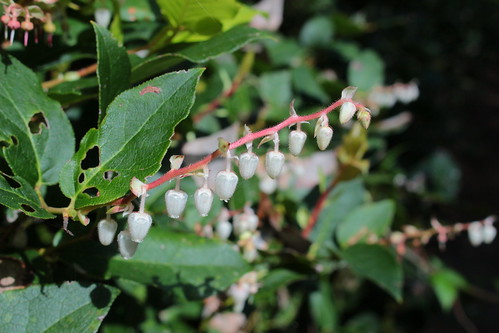Trail shot














ONTARIO, Ore. — White top, an invasive weed, has exploded to alarming levels in Malheur County this year.
“This is the worst it’s ever been,” said Oregon State University Cropping Systems Extension Agent Bill Buhrig, who has lived in the county for 40 years. “It’s all over the place.”
White top, also known as hoary cress, usually blooms in stages throughout the year, said Malheur County Weed Inspector Gary Page. But this year it appears to have exploded virtually all at once.
It has also appeared in remote areas far removed from any previously known white top infestation, he added.
“We’re reaching a tipping point most likely where it’s just going to explode” to a level where it’s not economically feasible to manage, Page said.
The noxious weed competes with beneficial plants, crowds out grasses and is noxious for cattle, Buhrig said.
Page said it has invaded a lot of alfalfa fields and irrigated pastures and, if the problem worsens, could have a major negative impact on livestock grazing, the backbone of the area’s economy.
“If we don’t do something pretty quickly, it could end up being a big economic issue in livestock production,” he said.
Page and Buhrig have sounded the alarm over the white top problem and are asking for landowners’ help in controlling it.
Because it’s a persistent weed and hard to kill, many people mistakenly assume it can’t be controlled and give up trying, Buhrig said.
“It can be controlled with some available herbicides and that’s what we’re really trying to emphasize,” he said. “You can fight it.”
There is still time to control the weed in 2016 even though it has flowered, Buhrig said. “Anything you can do this year to keep it from going to seed is a good thing.”
One of the reasons the weed has gained a local reputation as being uncontrollable is because many people are using herbicides that suppress it but don’t kill it and it returns the next year, Page said.
He said most people who try to control white top are applying Roundup and 2,4-D, neither of which is overly effective at controlling it. He recommends using metsulfuron methyl or chlorosulfuron.
He said he prefers to use chlorosulfuron but metsulfuron methyl is cheaper and landowners can expect to pay between $2-3 per acre for that herbicide.
Page said the weed has been in the area since the 1920s but has begun to expand rapidly over the last four or five years and has significantly altered many miles of native habitat along the Malheur and Owyhee rivers.
For more information about the weed, contact Page at (541) 473-5102 or gary.page@malheurco.org.
PORTLAND — A return to moderate weather has blessed Oregon’s early strawberry crop with good size and flavor, growers report, and bodes well for state’s other signature berries as the summer unfolds.
“The quality is really good now,” said Matt Unger of Unger Farms west of Portland.
Unger said his berries came through a winter that brought record rain to the Portland area, then withstood an early April heat wave that included a record 85 degrees measured April 7 at Portland International Airport.
The warm weather was good for pollination, however, as bees were active, and a return to more typical spring weather after the unseasonable hot spell has improved sizing, Unger said. “Seventy-five to 80 (degrees) gives you the most sweet, beautiful berries,” he said.
The farm specializes in Hood strawberries that it sells to the New Seasons grocery chain in the Portland area. Hoods, known for their superior taste, have achieved cult status with some consumers thanks in part to a public relations campaign that annually trumpets their appearance in New Seasons stores.
Tom Lodge of Townsend Farms, a grower and processor in the Portland area, said the company’s berries were small and green when the heat wave hit and so weren’t effected. The farm grows the Tillamook variety of strawberries, most of which go through IQF (Individually Quick Frozen) processing and are bagged for store sale under various labels.
“This year should be a very good year,” Lodge said. “I think yields will be up a little over the past couple years; the quality should be good.”
The company also grows and processes blueberries, blackberries and raspberries, all of which are “coming along really good,” Lodge said.
He said blueberries should be ready for picking by mid-June or slightly after. “By June 25 or June 28 we’ll be inundated with blueberries,” he said.
Oregon ranks first nationally in blackberry production, primarily Marionberries, and ranks third in raspberry and strawberry production and fourth nationally in blueberries and cranberries. Berry crops are worth about $165 million annually.
Lodge said the reason for Oregon’s berry success is “100 percent climate.”
“We have nice cool evenings — not cold, not hot but cool — and warm sunny days,” he said. “That combination, along with the rains the Pacific Northwest is known for, all of that added together makes this a prime area for growing berries.”
SALEM — The enforcement of Oregon’s labor laws for forest workers was criticized by employee advocates and industry representatives alike during a recent legislative hearing.
Unscrupulous labor contractors were roundly cast as the culprits in offenses ranging from wage theft to unsafe working conditions during the May 24 informational meeting before the Senate Interim Committee on Workforce.
Two reforestation workers testified they’re routinely not provided with adequate equipment, not paid for overtime and intimidated into lying about workplace injuries.
Meanwhile, labor law inspections rarely occur and employers are often forewarned when they do, the workers said.
“They don’t treat us like we were people,” Andres Cortez, one of the workers, said through an interpreter.
However, it wasn’t only workers and their advocates who spoke about enforcement problems in the reforestation industry.
Michael Wheelock, owner of contracting company Grayback Forestry, said he’s been appalled by the treatment of some workers, which he compared to modern-age slavery.
Not all labor contractors are unethical, but there are “horror stories” of exploitation among employers seeking to cut costs and underbid competitors, Wheelock said.
“There’s a lot of them abusing the situation,” he said.
It would help to “level the playing field” among contractors if enforcement authorities made an example of a few bad actors who disregard overtime and workers compensation requirements, he said.
“There needs to be enforcement of those regulations. We don’t need more,” Wheelock said.
Avel Salgado, who owns the Oregon Forest Management Services contracting firm, said he tries to treat employees fairly because he was a forest worker for a long time.
However, Salgado said there needs to be better enforcement, particularly unannounced inspections of work sites.
Holding employers accountable for following the law is an “issue of prioritization” for agencies charged with enforcement, said Scott Dahlman, policy director of the Oregonians for Food and Shelter agribusiness group.
The regulatory system on the books is robust, he said. “There seems to be some gaps in enforcement that need to be addressed.”
Michael Wood, an administrator at the Oregon Occupational Health and Safety Administration, acknowledged that his agency only conducts about 18 investigations of reforestation crews a year.
“That’s not an enormous presence,” he said.
While some industries receive less regulatory scrutiny, construction and other high-risk businesses are generally subject to more inspections, he said.
The presence of labor regulators among workers in Oregon is high relative to other states, but it has decreased in recent decades, Wood said.
In the early 1990s, for example, an average company’s chances of being inspected by OR-OSHA was once in 15 years, but it’s now closer to once in 32 years, he said. The number of inspectors hasn’t grown in proportion to the state’s economy, he said.
The agency also faces a challenge in inspecting mobile work sites, since it’s difficult to find out their location without alerting the employer, Wood said.
Having employers constantly apprise regulators of their whereabouts would be immensely expensive, but the agency is examining more effective ways of conducting unannounced inspections, he said.
When inspectors show up at a work site, contractors in nearby areas also quickly learn of their presence, Wood said. “It didn’t used to be as bad because people didn’t used to all have cell phones.”
A judge has declared a mistrial in a lawsuit that claims multiple residents of Curry County suffered health problems from off-target pesticide spraying.
Pacific Air Research, an aerial applicator, and landowner Joseph Kaufman were accused of negligence by 15 plaintiffs who sought $4.2 million in damages for physical ailments allegedly caused by herbicides sprayed in 2013.
A jury trial was underway when Curry County Circuit Court Judge Cynthia Beaman declared a mistrial and dismissed the case on May 23 under a provision of Oregon law that will allow the complaint to be refiled.
The case was dismissed because an attorney for the plaintiffs was hospitalized for medical problems, according to a spokesperson for the court.
Advocates for the agriculture and forestry industries were concerned about the dispute because the constitutionality of Oregon’s “right to farm” law was called into question during the litigation recently.
Under the “right to farm” statute, farmers and foresters are protected from lawsuits accusing them of nuisance and trespass for performing generally accepted industry practices.
The defendants in this case raised the “right to farm” law as a defense and asked the judge to throw out the lawsuit.
Plaintiffs responded by requesting that the “right to farm” law be declared unconstitutional because it deprived them of a legal remedy for an injury.
The Oregon Farm Bureau, the Coos-Curry County Farm Bureau and the Oregon Forest & Industries Council submitted “friend of the court” arguments supporting the statute, but the judge didn’t come to a decision on its constitutionality.
Judge Beaman allowed the case to proceed so the facts could be decided by the jury while taking under advisement the plaintiff’s motion to declare the “right to farm” law unconstitutional.
Opponents of the “right to farm” law have criticized it for preventing people harmed by pesticide trespass from having their day in court.
Natural resource attorneys, on the other hand, have said the statute doesn’t protect unlawful pesticide applications.
A 3,000-acre brush fire swept across the Umatilla Chemical Depot west of Hermiston, Ore., on Monday, closing Interstate 82 to traffic after smoke blocked visibility and caused a wreck that sent four people to the hospital for treatment.
Fire departments from around the region responded to fight the fire, which burned over the top of the hundreds of cement igloos that once held munitions. Two buildings also were destroyed.
Smoke from the fire limited visibility, causing a crash involving four motorcycles, a Mini Cooper, an SUV and a sedan.
A LifeFlight helicopter flew one victim from the scene and ambulances took three other injured people to Good Shepherd Hospital in Hermiston.
Flames flared up along the side of the road, at one point jumping the interstate and burning the sagebrush. All four lanes were closed to traffic for several hours.
Hermiston Fire spokesman J.W. Roberts said about 70 responders fought the fire and helped with the accident. They were from fire agencies in Umatilla and Morrow counties, plus members of the Oregon Military Department, state police and transportation department and the U.S. Bureau of Indian Affairs.
Nineteen engines and seven water tenders were dispatched, according to Hermiston Fire Chief Scott Stanton.
The spark of the fire may have come from an Oregon Army National Guard member training with an “artillery simulation round,” Roberts said, though the state military department considered the cause under investigation.
The U.S. Army is transferring the Umatilla Chemical Depot land to the Columbia Development Authority, a partnership of local government entities. Part of the land will be used for a National Guard training base, part of it will function as a nature preserve and some of it has been zoned industrial and will be marketed for economic development.
A reservoir expansion project in Oregon’s Hood River County has obtained $3 million as part of a bevy of water supply proposals recently funded by state regulators.
The money will cover roughly 70 percent of the cost of raising the Upper Kingsley Dam by nine feet, increasing its capacity by 50 percent, and replacing about two miles of leaky irrigation pipeline, which will reduce water losses by 15 percent.
The project is one of nine proposals to receive $8.9 million in grants from the state’s water supply development fund, which was created by lawmakers three years ago.
The Oregon Water Resources Commission signed off on the funding at its May 19 meeting, marking the first time that cash from the $14 million fund has been committed to projects.
Funding for the Kinglsey reservoir’s expansion was the largest investment made in the initial round of grant awards and represents the only project to create new water storage.
To receive the money, the project must release 25 percent of the newly stored water to increase streamflows and is subject to a “seasonally varying flow” analysis that may restrict its operations.
Most of the funding focuses on water conservation:
• $1.5 million to convert about 1,000 acres in Wallowa County from flood irrigation to sprinkler irrigation through the installation of center pivots, pumps and other equipment.
• $2.36 million to replace 12.5 miles of open canals with irrigation pipelines and make other improvements as part of three separate projects in the Tumalo, East Fork and Vale irrigation districts.
• $900,000 to install two deep water wells, pipelines and pumps in Wasco County.
• $600,000 to pay for fish passage and flow restoration modifications to the La Grande Reservoir in Union County.
• $250,000 to buy water rights and dedicate them to instream flows in Sun Creek to improve native fish habitat in Klamath County.
• $270,000 for equipment that would allow about 16,200 acre feet of drainage water to be recycled for irrigation in Klamath County.
Before the commission voted to approve the grants, the Middle Fork Irrigation District asked for its rejected application to be reconsidered.
The project, which would upgrade facilities to allow sediment-rich water to be used for irrigation, was ranked 10th in a list of 37 grant proposals, received many letters of support and had a significant amount of matching funds, said Craig DeHart, the district’s general manager.
“Our project was just as strong as other projects that were recommended for funding,” DeHart said.
The request sparked a discussion among commission members about how much money should be dispensed for projects, since $5.1 million was left in the fund for a second round of funding in 2017.
Commissioner Jeanne Lejeune questioned whether the remaining funds will hinder new appropriations from lawmakers.
“The legislature could say, ‘We gave you money, you had good applications, you didn’t spend all of it, and now you want more,” Lejeune said.
The Oregon Water Resources Congress, which represents irrigation districts, urged the commission to fund as many projects as possible during the first round.
The money will allow these projects to seek matching funds from other sources, said Lauren Smith, the group’s policy coordinator. “It gives them that leverage to go after those other funding programs.”
However, the commission ultimately rejected the idea of funding additional projects and voted to approve the nine proposals recommended by the Oregon Water Resources Department, which regulates state water.
PORTLAND, Ore. (AP) — A defense lawyer in the Oregon wildlife refuge occupation case argued Monday that a federal conspiracy charge leveled against over two dozen people is constitutionally vague, could threaten free speech and should be dismissed.
Attorney Amy Baggio made that argument and others on the first day of legal motions in the case stemming from the Ammon Bundy-led 41-day armed occupation of the Malheur National Wildlife Refuge that started Jan. 2, The Oregonian/OregonLive reported.
The conspiracy charge provides a “sphere of protection” for federal employees, but it’s so broadly worded that it could restrict free speech and assembly designed to criticize the federal government, Baggio said.
“This statute can chill, it can threaten not only First Amendment expression but the Second Amendment right to bear arms,” Baggio said.
The occupiers in their takeover of the refuge wanted the government to relinquish public lands to locals and free two imprisoned ranchers.
Assistant U.S. Attorney Ethan Knight challenged Baggio’s statements, saying the conspiracy statute in this case is not about speech but about conduct. Knight said what makes their conduct criminal is the conspirators’ agreement to prevent federal officers from doing their work at the refuge.
U.S. District Judge Anna Brown said the statute does not criminalize mere criticism or mere protest.
“It criminalizes force, intimidation or threats against public employees preventing them from doing their jobs,” the judge said. Brown added that it’s OK to criticize U.S. Bureau of Land Management employees, but preventing them from doing their work on their property isn’t allowed under law.
The defense also wants a weapons charge against some of the occupiers dropped. It accuses some of the defendants of using or carrying a firearm to further a crime of violence. They contend that the underlying conspiracy isn’t a “violent crime.”
Knight argued the underlying conspiracy represents a violent crime, but he conceded that determining that presents a “close call” for the court.
Defense lawyers also asked prosecutors to give more specifics on the allegations against each defendant, to help determine who might go to trial together.
Brown says she’ll rule on the motions in the near future.
A Nevada man who participated in the Oregon occupation pleaded guilty last week to a federal conspiracy charge. In exchange for Corey Lequieu’s plea, prosecutors agreed to drop weapons charges.
The trial for the other 25 defendants is set for Sept. 7.
Select the newsletter(s) to which you want to subscribe or unsubscribe.